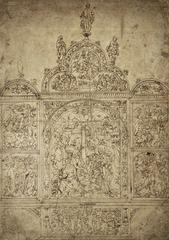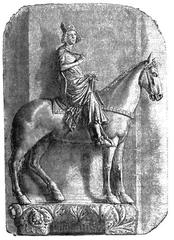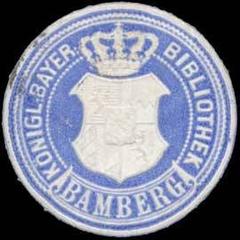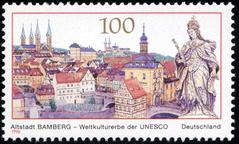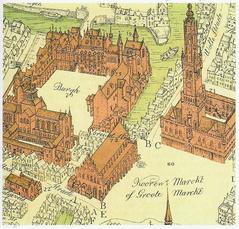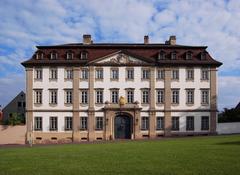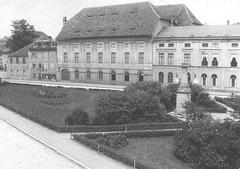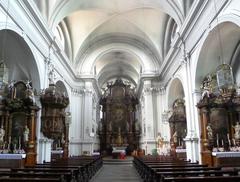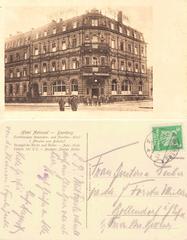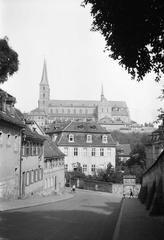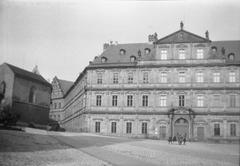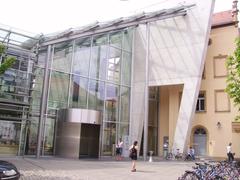Katholisch Bamberg: Visiting Hours, Tickets, and Historical Sites Guide
Date: 14/06/2025
Introduction: Bamberg’s Catholic Heritage
Situated in the heart of Bavaria, Bamberg is a city where history, faith, and culture converge. Known as the “Franconian Rome” for its seven hills, each topped by a church, Bamberg offers a rare and immersive journey through over a millennium of Catholic tradition. Founded as a bishopric by Emperor Henry II in 1007, Bamberg grew into a spiritual and political center, famed for its remarkable religious architecture and enduring Catholic customs (Nomads Travel Guide; The Catholic Travel Guide).
The city’s crowning jewel, the Bamberg Cathedral (Bamberger Dom), houses the tombs of saints and a pope, making it a major pilgrimage destination. This guide presents an in-depth look at Bamberg’s Catholic sites, history, and culture, with detailed practical information on visiting hours, tickets, accessibility, events, and travel recommendations. Whether you are seeking spiritual insight, architectural marvels, or a vibrant festival experience, Bamberg is a living testament to Catholic heritage (Laid Back Trip; ADAC).
Contents
- Foundations of Catholic Bamberg: From Imperial Vision to Bishopric
- Medieval Catholic Power and Urban Development
- Reformation, Counter-Reformation, and Baroque Catholicism
- Catholic Heritage Sites: Cathedrals, Churches, and Monasteries
- Visitor Information: Hours, Tickets, Accessibility
- Catholic Festivals and Cultural Events
- Nearby Attractions and Photo Spots
- Bamberg Cathedral: Historical Background, Architecture, and Visitor Guide
- Domplatz: Key Heritage Sites, Events, and Tips
- Exploring Bamberg’s Catholic Life Today
- FAQs and Practical Tips
- References and Official Links
1. Foundations of Catholic Bamberg
Bamberg’s Catholic roots stretch back to the early Middle Ages. The city was first mentioned in 902 AD, but its destiny as a major Catholic center was sealed when Henry II established the bishopric in 1007. This move was both spiritual—aimed at spreading Christianity eastward—and political, ensuring imperial control over the region. Lavish endowments and the deliberate echo of Rome’s seven hills cemented Bamberg’s status as a “second Rome” (Nomads Travel Guide; Laid Back Trip).
2. Medieval Power and City Development
The prince-bishops of Bamberg shaped the city’s development, commissioning monumental churches and monastic complexes. The construction of Bamberg Cathedral, begun in 1004 and consecrated in 1012, marked the city as a spiritual heart of the Holy Roman Empire. The cathedral, with its four towers, became a focal point for both urban life and the Catholic faith (Germany Travel; Joey is a Traveler).
3. Reformation, Counter-Reformation, and Baroque Splendor
Though the Protestant Reformation swept through much of Germany, Bamberg remained staunchly Catholic, resisting change under the leadership of its prince-bishops and the Jesuits. This period saw a flourishing of Catholic art and architecture, especially during the Counter-Reformation. Notable is St. Martin’s Church, built in the baroque style and consecrated in 1693, reflecting both religious and artistic renewal (Spotting History).
The 17th and 18th centuries brought further grandeur, with the construction of the Neue Residenz, the Baroque Rose Garden, and elaborate ecclesiastical buildings. The city’s unique political structure—combining secular and religious authority—found expression in its skyline and public life (Nomads Travel Guide; The Crazy Tourist).
4. Catholic Heritage Sites
Bamberg Cathedral (Bamberger Dom)
A masterwork of Romanesque and Gothic architecture, the cathedral is home to the tombs of Emperor Henry II and Kunigunde, both saints, and Pope Clement II—the only pope interred north of the Alps. The famous Bamberg Horseman statue and an array of medieval treasures await visitors (Germany Travel).
- Hours: 9:00 AM–6:00 PM daily (April–October), 9:00 AM–5:00 PM (November–March)
- Admission: Free; guided tours €5 per person
- Accessibility: Wheelchair accessible except for crypt and upper galleries
St. Martin’s Church
Bamberg’s only baroque church, with Jesuit heritage and notable frescoes, open 10:00 AM–5:00 PM. Tickets for concerts and events available at the door (Spotting History).
Michelsberg Monastery
Former Benedictine abbey with panoramic city views; currently under restoration but its grounds are accessible (Wanderlog).
Our Lady’s Parish Church (Obere Pfarre)
A Gothic gem with vibrant parish life, open during services and events.
5. Visitor Information: Hours, Tickets, Accessibility
- Cathedral: Free entry, guided tours available for a fee. Wheelchair access to most areas.
- Other Sites: Some, like the Diocesan Museum and Neue Residenz, require tickets—combined tickets may be available.
- Guided Tours: Book online or at the Bamberg Tourist Information Centre. Virtual tours offered on official websites.
- Transport: Bamberg is walkable; public transport and parking available near the Old Town.
6. Catholic Festivals and Events
- Bamberg Christmas Market: Held in Maximiliansplatz during Advent, featuring festive stalls and Catholic masses (Happy to Wander).
- Sandkerwa Festival: Every August, celebrating the consecration of St. Elisabeth’s Church with processions and local traditions, drawing hundreds of thousands of visitors.
7. Nearby Attractions and Photo Spots
- Rose Garden: Unmatched city views, ideal for photography (The Crazy Tourist).
- Old Town & Altes Rathaus: Wander cobblestone streets and see the iconic Old Town Hall perched above the Regnitz River.
8. Bamberg Cathedral: History, Architecture, and Visiting Guide
Historical Background
Founded in 1004 by Henry II, the cathedral has survived two major fires; the current structure dates from 1215–1237, blending Romanesque and Gothic styles. It is the burial site of Henry II and Kunigunde, as well as Pope Clement II (en.wikipedia.org; en.bamberg.info).
Architectural Highlights
- Exterior: Four towers dominate the skyline; east towers are Romanesque, west towers Gothic (cwshier.com).
- Interior: Features the Bamberg Horseman, Riemenschneider’s tomb sculptures, Veit Stoß altars, and medieval stained glass (winedharma.com; meticulousmeanderings.com).
Visiting Hours and Tickets
- Hours: Open daily outside of service times. Guided tours require advance booking; group tours limited to 20 per guide (bamberger-dom.de).
- Quiet Days: On major religious holidays, tours and loud explanations are suspended.
Guided Tours and Experiences
Options include in-depth cathedral tours, treasure and cloister highlights, and old town walks. Organ concerts and special cultural events are regularly held.
Accessibility
Most public areas are accessible; some historic sections like the crypt are not. The Domplatz and surrounding district are pedestrian-friendly, but cobblestones may be challenging.
Visitor Tips
- Non-flash photography allowed except during services.
- Dress modestly out of respect for the sacred space.
- Combine your visit with nearby museums, gardens, and the old town (wanderineurope.com).
9. Domplatz: Key Heritage Sites, Events, and Visitor Tips
Domplatz and Surroundings
The Domplatz (Cathedral Square) is Bamberg’s historical heart, surrounded by the cathedral, Alte Hofhaltung (Old Court), Neue Residenz (New Residence), and the Diocesan Museum. Each site offers unique insights into Bamberg’s spiritual and civic history (explorial.com; adac.de).
- Diocesan Museum: Ecclesiastical treasures, imperial regalia, and relics from Pope Clement II.
- Alte Hofhaltung: Former bishop’s residence and city museum, with medieval and Renaissance art.
- Neue Residenz: Baroque palace with lavish interiors and the Rose Garden.
- St. Michael’s Monastery: Currently under renovation; famous for painted herbal ceilings.
Events and Tips
- Corpus Christi Procession: Annual event with relics paraded through Domplatz.
- Christmas Market: The square hosts festive markets and concerts.
- Accessibility: Cobblestones may be challenging, but most main attractions have ramps or alternative entrances.
10. Bamberg’s Catholic Life Today
Catholicism continues to shape Bamberg’s festivals, education, and community services. Despite modern challenges, the city maintains vibrant parish life, musical heritage, and social outreach (shunculture.com; NCR Online).
11. FAQs About Visiting Catholic Bamberg
Q: What are the opening hours for Bamberg Cathedral?
A: 9:00 AM–6:00 PM (April–October); 9:00 AM–5:00 PM (November–March). Closed during some religious holidays.
Q: Is cathedral entry free?
A: Yes, but guided tours have a fee.
Q: Are guided tours available?
A: Yes, in multiple languages; book online or at the Tourist Information Centre.
Q: Is the cathedral accessible?
A: Most areas are accessible; some historic sections are not.
Q: When is the Sandkerwa festival?
A: Every August.
Q: Can I take photos inside?
A: Yes, non-flash only and never during services.
12. Practical Visitor Tips
- Visit early to avoid crowds.
- Wear comfortable shoes for hilly, cobbled streets.
- Dress modestly in churches.
- Book tickets and tours in advance for special events.
- Don’t miss panoramic photos from the Rose Garden.
13. Visuals and Media
Enhance your visit with images and virtual tours on the Bamberg Tourism Website. Suggested alt tags: “Bamberg Cathedral exterior view,” “Bamberg Horseman statue,” “Panoramic view from Rose Garden.”
14. Call to Action
Download the Audiala app for audio-guided tours, up-to-date visiting hours, and exclusive discounts. Follow us on social media for Bamberg travel tips and stories. For more, see Catholic Architecture in Bavaria and Historical Churches of Germany.
15. Summary and Recommendations
Bamberg’s Catholic legacy is woven into its streets, festivals, and architectural wonders. From imperial foundations and magnificent cathedrals to lively traditions and modern outreach, the city offers a profound journey through faith and history. Plan ahead for the best experience—explore guided tours, participate in festivals, and use resources like the Audiala app to enrich your visit (Germany Footsteps; The Crazy Tourist).
References and Further Reading
- Nomads Travel Guide
- Wikipedia: Bamberg Cathedral
- en.bamberg.info: Bamberg Cathedral
- ADAC: Bamberg Sights
- Explorial: Bamberg Domplatz
- The Catholic Travel Guide
- Germany Footsteps
- Wander in Europe
- The Crazy Tourist
- Bamberg Cathedral Official Site
- Spotting History: St. Martin’s Church
- Happy to Wander
- Winedharma
- Joey is a Traveler
- Meticulous Meanderings
- Annees de Pèlerinage
- From Place to Place Travel
- Shun Culture
- NCR Online

